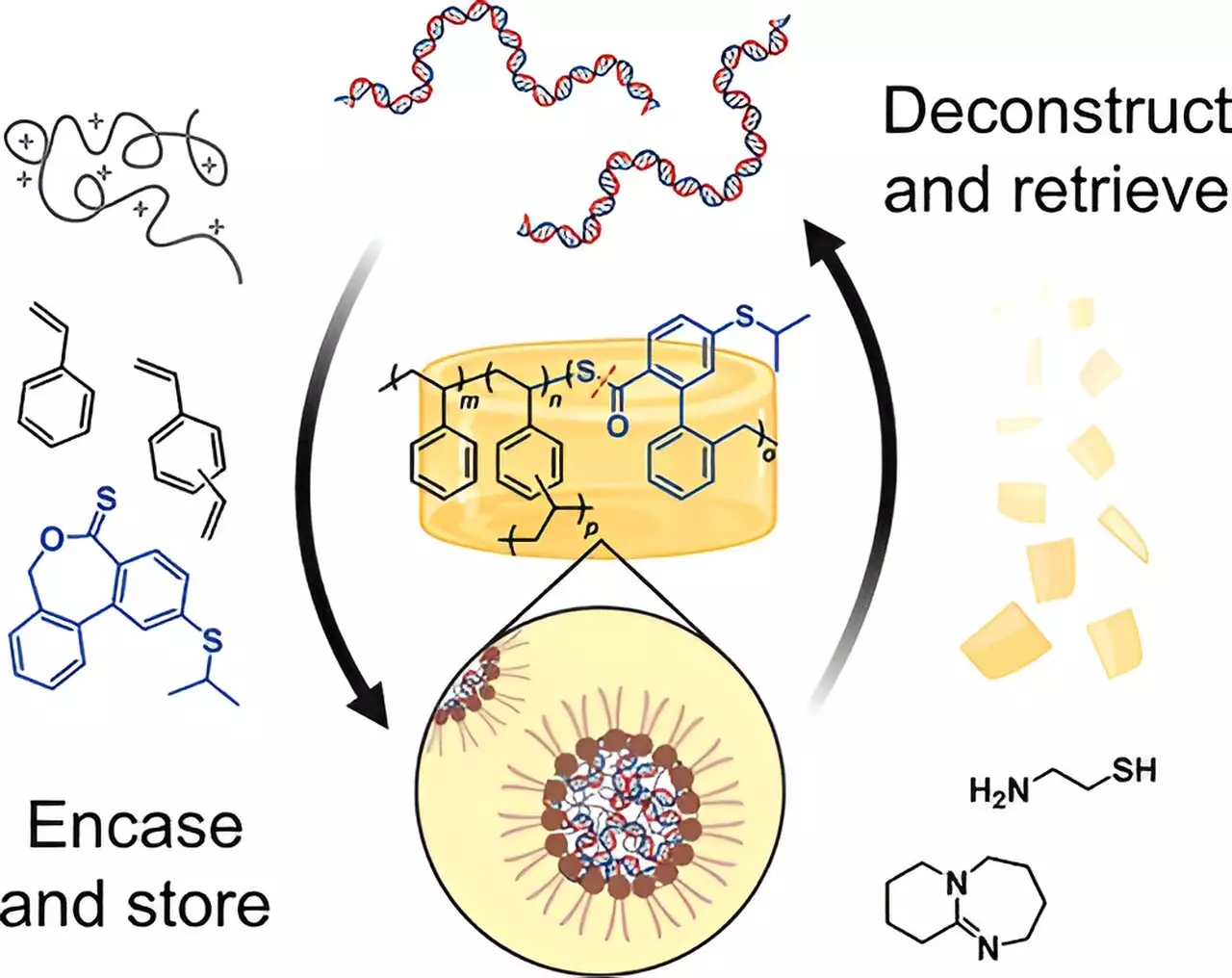The concept of preservation has long fascinated humanity, from ancient caves to cutting-edge laboratories. Perhaps no metaphor captures this urge more vividly than the depiction of dinosaurs preserved in amber in the blockbuster “Jurassic Park.” This visual narrative has inspired scientists to rethink how we might safeguard our most precious biological and digital information into the future. Recent advancements from MIT researchers have taken a significant leap toward that goal by designing a novel polymer that mimics amber, providing a durable, energy-efficient medium for long-term DNA storage. This breakthrough does not merely offer a new pathway for biological preservation; it promises to revolutionize the very fabric of data storage technology—an intersection where nature-inspired ingenuity meets technological ambition.
The core innovation lies in transforming the traditional method of freezing DNA—which is energy-intensive and often impractical—into a process more aligned with natural preservation. Freezing requires extensive cold storage infrastructure, an expensive and environmentally taxing process that limits accessibility. By contrast, the new amber-like polymer provides a habitat where DNA can be stored at room temperature, shielded from heat, water, and other degrading factors. Through this, researchers aim to democratize the capacity to preserve human genomes and digital information universally, regardless of geographic or infrastructural limitations.
This approach signifies more than just a technical upgrade; it embodies a paradigm shift. Imagine a future where your photographs, music, or medical records are embedded in a natural-looking resin, resilient and stable for centuries, much like ancient amber. This is not science fiction anymore. The potential applications extend beyond personal memorabilia into critical fields such as medical genomics, archival data storage, and even disaster-proof information repositories. More importantly, this technology challenges the long-held necessity of cryogenic storage, suggesting that sustainable and scalable solutions are within reach, driven by the very materials and principles nature has perfected over millions of years.
Reimagining DNA as a Digital Archive
DNA’s whispering promise as a perfect archival medium has been well-known in scientific circles. Its incredible information density—theoretically allowing all of humanity’s data to fit into a single coffee cup—is mesmerizing. Entwined with the four-letter genetic alphabet, digital information can be encoded in a biological format that offers unparalleled stability and longevity, far surpassing traditional solid-state or magnetic storage media. However, harnessing DNA at scale has been hampered by challenges related to synthesis, sequencing, and, notably, preservation.
MIT’s recent work tackles this issue head-on, building upon previous innovations to craft a polymer that encapsulates DNA much like how nature preserves its ancient specimens. Unlike earlier silica-based methods that required days to embed DNA—and used hazardous chemicals—this new polymer process is faster, safer, and more environmentally friendly. It employs a sophisticated interplay of hydrophobic and hydrophilic interactions, creating a spherical complex where DNA resides comfortably within a protective shell, stabilized in a glassy, amber-like matrix. Such a setup shields the genetic material from thermal stress, moisture, and other environmental threats, effectively sealing it in a state akin to permanent fossilization.
This polymer, designated T-REX (Thermoset-REinforced Xeropreservation), is not just a clever encapsulation device. Its design cleverly integrates cleavable bonds, meaning the DNA can be retrieved intact whenever needed. This bidirectional capability—embedding and extraction—underscores the practicality of the technology. Moreover, the process takes mere hours, promising scalability and ease of deployment. Imagine entire genomes, digital archives, or cultural artifacts stored in microscopic capsules, ready to be accessed for future generations.
One unavoidable truth in biological data storage has been the fragility of the medium. The team’s ability to store and retrieve error-free DNA after exposure to temperatures as high as 75°C is testament to the robustness of this approach. It alleviates the persistent anxiety about data loss over centuries, an essential step toward genuine long-term archiving. The implications extend into personalized medicine, where genomes may be preserved for decades or even centuries and reexamined as scientific understanding progresses. This approach could redefine what it means to archive life itself.
Beyond the Laboratory: Real-World Impact and Ethical Considerations
While the technological achievements are impressive, they also prompt us to reflect critically on broader implications. The ease of storing colossal amounts of information as DNA raises questions about privacy, security, and ethical stewardship. If personal genomes or sensitive digital data can be effortlessly embedded and preserved in amber-like capsules, how do we safeguard this treasure trove from misuse or unauthorized access?
Furthermore, the environmental and economic benefits of room-temperature storage cannot be overstated. Moving away from costly cold-chain logistics reduces energy consumption and makes archival storage more accessible worldwide. Imagine regions where cold storage is infeasible finally entering the digital age with resilient, naturalistic storage capsules now within reach. This democratization of data preservation aligns with a vision of equitable access and sustainability—a crucial step in our increasingly digital world.
Critics, however, might argue that the race toward biological storage could encounter unforeseen hurdles. The manufacturing and scaling processes need refinement; current methods, while promising, still require hours and specialized chemicals. There are also questions about the long-term integrity beyond decades—centuries, or even millennia. Will the polymer maintain its protective qualities indefinitely, or will degradation eventually compromise stored DNA? The urgency lies in rigorous testing, ethical frameworks, and proactive governance to prevent misuse and ensure these futuristic capsules serve humanity positively.
Bottom line, this innovation embodies a daring leap forward—an assertion that preserving the essence of life, knowledge, and history is possible in a form more resilient and adaptable than ever imagined. It urges us to rethink our approach to memory, legacy, and the very fabric of digital existence. The journey from amber fossils to amber-like polymers encapsulates an inspiring narrative of human ingenuity, driven by love for knowledge and a desire to keep our stories alive for eternity.


Leave a Reply